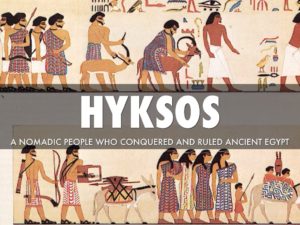 The story of the Exodus is currently unpopular amongst scholars because, supposedly, of the lack of evidence of the event in Egyptian writings. In my opinion the scholars are sharing the antisemitism of writings of Manetho, alter time Egyptian priest who demeaned the Semitic rulers of Egypt, the Hyksos.
The story of the Exodus is currently unpopular amongst scholars because, supposedly, of the lack of evidence of the event in Egyptian writings. In my opinion the scholars are sharing the antisemitism of writings of Manetho, alter time Egyptian priest who demeaned the Semitic rulers of Egypt, the Hyksos.Two arguments bolster the scholar’s skepticism. The first is the dates of the Hyksos expulsion from Egypt. If one accepts the biblical chronology, the Hyksos defeat is about 2oo years too early for the story of Exodus. This seems bizarre … why would sc

“Semites have moved into Egypt. They have seized the harvests, diverted the streams, and drained the fish ponds. The custom of ritual, sanitary burial has been abandoned, and dead bodies are now thrown into the river. Social chaos abounds in the land, and the natural aristocratic order has been turned upside down. Murder happens in broad daylight, and people look the other way. The ties of kinship have been weakened so that men no longer love their brothers. Everyone demands to be accepted as they are, saying ‘Love me!’ but everything good in life has disappeared. Property is taken away from its rightful owners and given to others. If someone ventures an unpopular opinion, others reach for sticks and say ‘Kill him!’ The people become poorer while taxes and bureaucrats increase. The better people lose so that the inferior might gain.”
holars expect true history to be seen in the oral legends of the Torah?
New archaeological finds in Israel support my concept. At a site in Tel Hazor National Park, north of the Sea of Galilee Hebrew University
archaeologists, Prof. Amnon Ben-Tor and Dr. Sharon Zuckerman have found evidence of an ancient Egyptian leader in northern Israel. They found a Sphinx! This amazing object is not from the Hyksos did not build Pyramids or Sphinx’s.
This Sphinx appears to be belong to one of the ancient pyramid-building pharaohs. The object appears to have been brought over from Egypt, with a hieroglyphic inscription between its front legs. The inscription bears the name of the Egyptian king Mycerinus, who ruled in the third millennium BCE, more than 4,000 years ago. The inscription includes the descriptor “Beloved by the divine manifestation … that gave him eternal life.” According to Prof. Ben-Tor and Dr. Zuckerman, this text indicates that the Sphinx probably originated in the ancient city of Heliopolis (the city of ‘On’ in the Bible), north of modern Cairo. It is highly unlikely that the Sphinx was brought to Hazor during the time of Mycerinus, since there is no record of any relationship between Egypt and Israel in the third millennium BCE and Egypt had yet to become a great power, occupying the Levant.
To add to the mystery, this Sphinx was discovered in the destruction layer of Hazor that was destroyed during the 13th century BCE, according to the archaeologists. This is also too early for the usual estimates of the Exodus … but not all that much since the earliest firm dates we have are for David’s occupation of Jerusalem about 1000 BCE. The archaeologists argue that the statue was brought to Israel in the second millennium BCE during the dynasty of the kings known as the Hyksos, who originated in Canaan.
This theory is supported by documents discovered at Hazor and at sites in Egypt and Iraq attest that Hazor maintained cultural and trade relations with both Egypt and Babylon. Artistic artifacts, including those imported to Hazor from near and far, have been unearthed at the site. Hazor is currently one of Israel’s national parks.